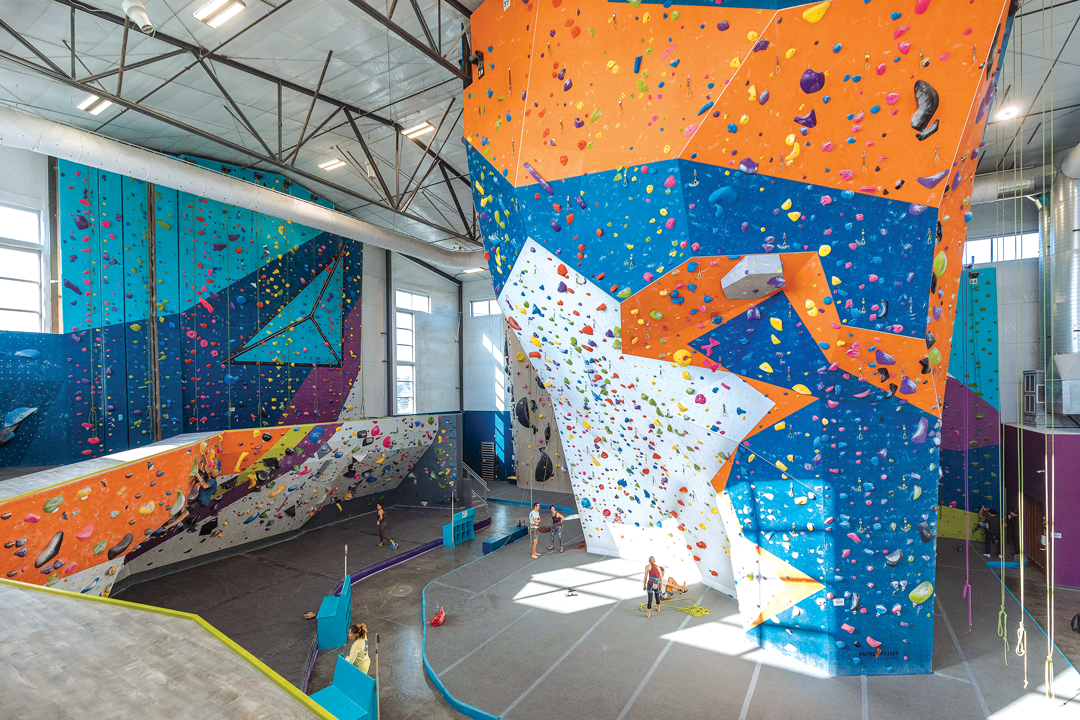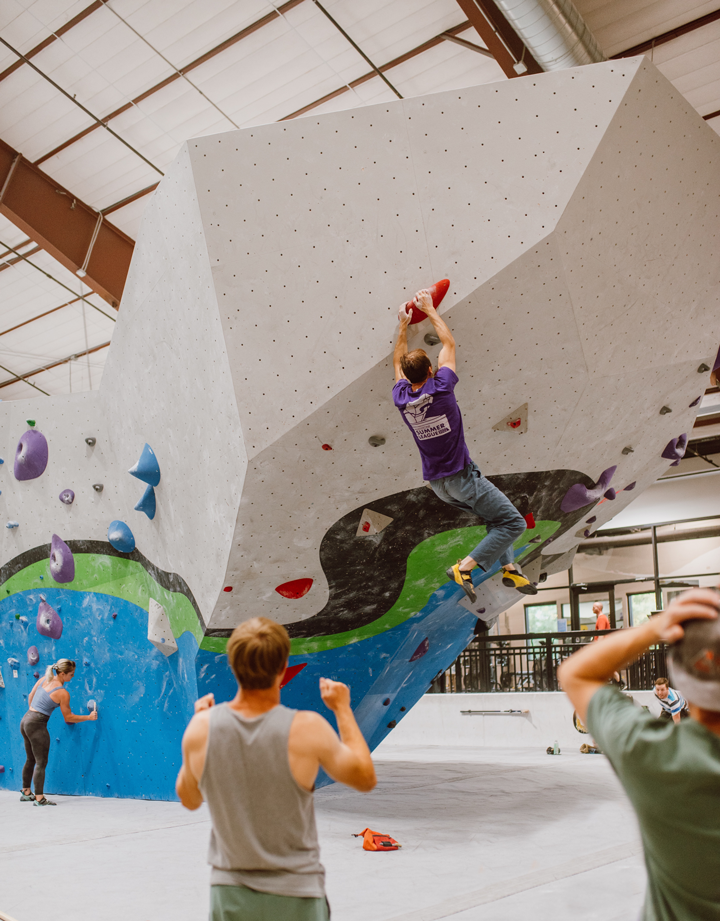Ryan Mahoney walked into Ascent Studio Climbing & Fitness with his oversized shoes, a day pass and a desire to do something to satisfy his competitive spirit after wrestling in college. He wasn’t looking for a community. In fact, he was doing whatever he could to avoid it.
Mahoney was shy. He chose the solo bouldering walls at Ascent, a rock climbing facility he picked because it was the closest gym to his parents’ house in Fort Collins. That way he wouldn’t need a belay partner or, really, anyone else.
Then he heard a voice over the music in his headphones, and his head snapped up. “Hey dude,” the climber said, “do you want to rope up with us?”
Now, a year later, Mahoney, 23, who works as a manager for The Picklr in Loveland, is one of the more popular climbers at Ascent. He loves the people, the vibe and the community there. He’s even spent a couple days outside climbing with others near Horsetooth Reservoir.

Ascent Studio Climbing & Fitness, Fort Collins.
“Once you find that way in, it becomes so easy,” Mahoney says. “It was easier than I thought it would be.”
Climbing gyms aren’t the only places to learn how to scale rock. Some start outside, and others learn how to climb indoors through city recreation programs. But climbing gyms market themselves by offering more than colored rock walls: They have other climbers and seemingly endless ways to meet them, including dozens of events per month.
Ascent and other climbing gyms offer leagues, classes and get-togethers for women, families, couples on a date, gym dogs and those who identify as queer. In fact, many of the get-togethers are designed to strip the gyms of the toxic “broness” of the past.
Jon Lachelt, who built Ascent in 2016 with his business partners after 29 years of working at Hewlett-Packard, works as the general manager. He began requiring shirts soon after the gym opened as one way of being welcoming, even as some members (ahem, bros) complained about the policy. Perhaps as a result, Lachelt knows he has more female members than ever.
Ascent’s climbing leagues, which would seem to be the place where the broness could fester, actually are breeding grounds for tips and tricks and encouraging one another, he says.
“Climbing seems like a solitary sport, but you can’t do it alone,” Lachelt says. “We want people to talk to each other.”

A climber on the bouldering wall at Whetstone.
A welcoming atmosphere
Welcoming new climbers with “open arms,” as Jeremiah Wall, marketing manager and event coordinator for Whetstone Climbing puts it, is important because there are so many reasons for new climbers to feel uncomfortable.
The climbing alone is hard enough, Wall says, given that many people are uneasy, if not downright scared, to be more than a few feet off the ground. It’s also technical, with a lot of unfamiliar terms, new equipment and nearby climbers who are so experienced that it feels like they came out of the womb with a harness strapped to their waist.
“But by getting ingrained into the community here, with a rope and a partner,” Wall says, “45 feet off the ground is not as high as it seems.”
Wall himself was hesitant to get into rock climbing years ago. It took a good friend to get him past his own insecurities to give it a try.
“He had to drag me by the ear,” Wall, now 40, says.
The Greeley Recreation Center began offering programming for its climbing wall in 2022, and many of their classes cater to women’s groups, kids and families. They also host weekly summer camps full of “mini monkeys” ages 5-9 and “billy goats” ages 10-15.
“Those are already nearly full,” Armando Asseiss, recreation coordinator for the City of Greeley, said in late April, “and it’s not even May yet.”
Asseiss wants to host a climbing competition, so he’s not opposed to combat climbing, but he also wants his instructors to set an encouraging vibe. He’s especially pleased to see families climbing together.
“That’s been so popular,” he says. “It’s a good time to spend with the kids.”

Jeff Snyder climbing the Prometheus Rising route in the Poudre Canyon.
Climbing outdoors
Wall believes there’s an advantage to learning how to climb indoors because it removes a lot of external factors that make it scarier, including rockfall and harsh weather. But he also encourages climbers to get outside when they’re ready.
“Our gym caters to the outdoor climber,” he says. ‘We take great pride in that.”
Some climbing instructors teach both indoor and outdoor climbing, including Jeff Snyder, adult programs coordinator for Ascent. Snyder guides for the group NOCO Climbing Guides as an outdoor rock climbing instructor. Many indoor gyms are hesitant to offer their own outdoor instruction because of the liability, but they don’t mind instructors advertising their side hustles.
Snyder also likes indoor climbing because of the flexibility it offers, but part of the draw of rock climbing, he says, is to get outside.
“When you have a couple hours after work, having a climbing gym is really a positive. It’s easier to make it a lifestyle, ” he says. “But it can also be a driving force to being outside and getting into the mountains. I love being an outdoor rock climber.”
Heading outside can be tougher for beginners, Snyder says. He recommends knowing how belays work and how equipment functions, at least on a basic level, before asking others to head out.
“If you ask someone enough, people are willing to carry you under their wing,” Snyder says. “You can’t be wild. Most climbers will want to feel like they are a partnership, not a bus driver. And as a climber, you don’t want to do that to your partner, either.”
Snyder says his job as a guide is to bridge that gap for beginners so they learn from him and gain enough confidence to eventually go out on their own.
Respect for the environment
The outdoors has its own set of ethics, too, including stewardship and conservation. The Northern Colorado Climbers Coalition helps preserve routes in the area, including some iconic climbs in the Horsetooth Reservoir area that were put up in the 1950s.
“There are climbing areas that are sacred playgrounds to climbers. They have history,” says Ben Scott, a board member of the coalition.
In late April, however, a climber unintentionally ripped a chunk of rock out of one of those sacred sandstone walls because he didn’t wait the typical three days for the wall to dry after the heavy spring rain and snow, Scott says. The route was a favorite for 70 years and was loaded with history, pioneered by John Gill, who is widely regarded as the father of bouldering.
The coalition took a poll among its members: Should they glue the rock back on or let nature have its way? Some said a human, not nature, caused the problem, so it was OK for humans to fix it, while others argued that rocks eventually do crumble and to let it be. Ultimately 250 people responded, and the majority decided to let nature win.
“It was a great discussion of ethics,” Scott says.
The coalition tries to educate climbers on issues like this as well as build bridges between landowners and climbers, resolve disputes and, sometimes, help maintain climbing areas (including the bulk of Fort Collins’ routes, which are in the Arapaho and Roosevelt National Forests). The coalition is a volunteer-run organization and encourages climbers to use the vast outdoor resources available in Northern Colorado.
“There’s no climbing police,” Scott says. “We have no authority. There’s not even a climbing management policy on forest service land, but even then, we want to foster relationships between us and them.”
Finding mentors in a gym is perhaps the most important thing a climber can do, Wall says, and Mahoney credits his own climbing success to the expertise others have shared with him. This makes Wall happy. It means the climbing gyms are fulfilling their mission.
“It’s important to us that finding kindred spirits in this seemingly crazy activity is the net positive here,” Wall says. “The more people you share it with, the more you can spread it to others.”







